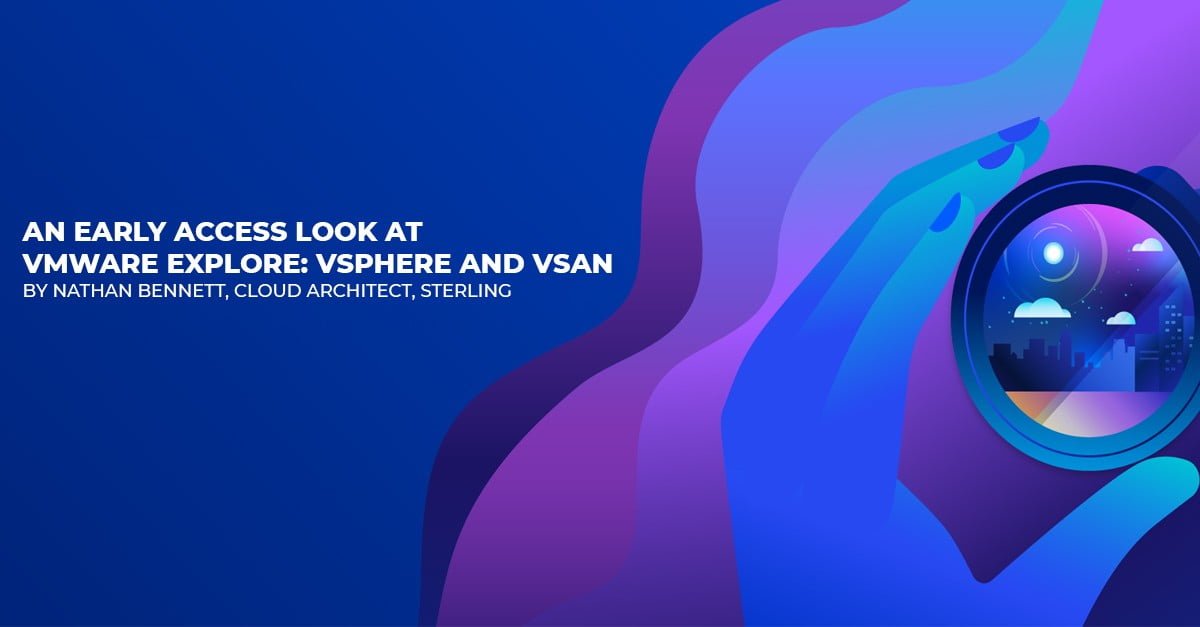By Nathan Bennett, Cloud Architect, Sterling
I recently had the chance to take part in some first-look webinars leading up to VMware Explore 2022. The sessions were built around new solutions within the VMware portfolio, including in compute, storage, networking, and the cloud. Our group was privileged to be among the first to hear announcements that will be done publicly during VMware Explore’s keynote and breakout sessions.
I’ll let you in on some of the stuff that impressed me the most (and that is likely to grow VMware’s market share). But to avoid being a complete spoiler, I won’t do a comprehensive reveal of the announcements or go into deep technological detail about the new offerings or capabilities. For that and more information coming out of VMware Explore, tune into the VMware News feed: https://news.vmware.com/ .
It’s worth noting at the outset that the multi-cloud agenda was a huge part of the conference’s name-change this year, from VMworld to VMware Explore. You might presume then that cloud computing would take center stage in the arena. But the announcement of vSphere and vSAN+ this past spring made it clear that “Cloud” isn’t really the destination of our big three public clouds. The focus is on software as a service (SaaS) and software-defined datacenters and how customers can work within their respective VMware environments to make their lives easier day to day.
New in vSphere 8
- vSphere Distributed Services Engine (formerly Monterrey) will now unlock a DPU (Data Processing Unit) by utilizing network-offloading via NSX. This allows DPU integration directly through the vSphere interface.
- vSphere with Tanzu
-
- Unification of multiple TKGx runtimes into a single TKG runtime that runs everywhere, including in vSphere and public clouds
- Workload-availability zones for multiple-workload environments.
- Declarative-cluster lifecycle with ClusterClass, allowing users to create a declarative manifest for their clusters
- Customization of Photon OS or Ubuntu images for Tanzu deployment
- Pinniped integration with Tanzu, allowing LDAP integration outside of the vSphere integrated LDAP connections.
- vSphere 8 is the last version of vSphere to use baseline (VUM) update methods. (It now uses Lifecycle-Manager images.) Stage updates are done with Lifecycle Manager.
- *Tech Preview – vSphere Configuration Profiles (replacing host profiles) define host configurations at the cluster level, and that configuration can then be pushed down to each host.
- vCenter is now more resilient, enabling clusters to be reconciled after failure or restores.
- Unified management of AI/ML hardware accelerators with compatible drives is now possible, allowing GPUs to be consumed in a much easier fashion. This can be done now through vCenter and eventually through NVIDIA, after vSphere 8 goes GA [generally available].
- Virtual Hardware V.20 will now allow Virtual TPM Provisioning Policy (deploying Windows 11 at scale.) The TPM device can be cloned to replace or reset the vTPM device as new so that Windows 11 will not re-use TPM devices. Copies will still be there, for instance, when copying is needed. (Those pesky windows updates!)
New in vSan 8
- vSAN Express Storage Architecture (ESA) removing disk groups (no storage or cache groups) from a required setting. Customers easily transition with approved hardware and licensing. They then migrate via vMotion or Storage vMotion. vSAN ESA is looking to be so fast that the data bottleneck may move from the storage layer to the network layer.
- IVMware Cloud Flex Storage — Enterprise-class cloud storage and data management as a service for multi-cloud, with a pay-as-you-go consumption model. This permits application and data consumption in the multi-cloud space so third-party cloud integrations (like AWS, Azure, and GCP) could consume this data independently of the compute resources.
Out of all VMware’s announcements of new capabilities and features, the integration of artificial intelligence and machine learning and DPUs is — in my opinion — the most striking.
We have seen workloads continually grow in this space, from K8s integration to more. It’s worth noting that through services like NVIDIA Grid, which allow workloads and pods to have GPUs assigned, these AI/ML solutions can continue to be developed, released, and maintained.
Don’t underestimate the small things — like news that VMware is combining all the TKG runtimes into a centralized runtime across on-premises and cloud. TPM for Windows 11 is going to be a great headache-reliever for anyone who wants to run Horizon with clients on the new Windows OS. (I’m a huge OS fan.)
Tanzu integrations with vSphere — that’s also a step in the right direction. We’ve heard from several customers wishing to maintain resiliency for TKG clusters. This will afford great resiliency and versatility. Storage is getting better, faster, and easier with vSAN and Flex Storage. These services definitely have places in the enterprise workplace. Data storage is an easy, smart way to start consuming cloud. VMware obviously knows that the first obstacle after starting to consume cloud storage is vendor lock-in, so they bypass it to make their storage more accessible.
That’s all for now. Sterling will be present at VMware Explore 2022, of course, so keep an eye out for more of our content commentary here during this week. I’ll be on the show floor asking people what these announcements will mean to them and will blog some of the responses. Stay tuned.

